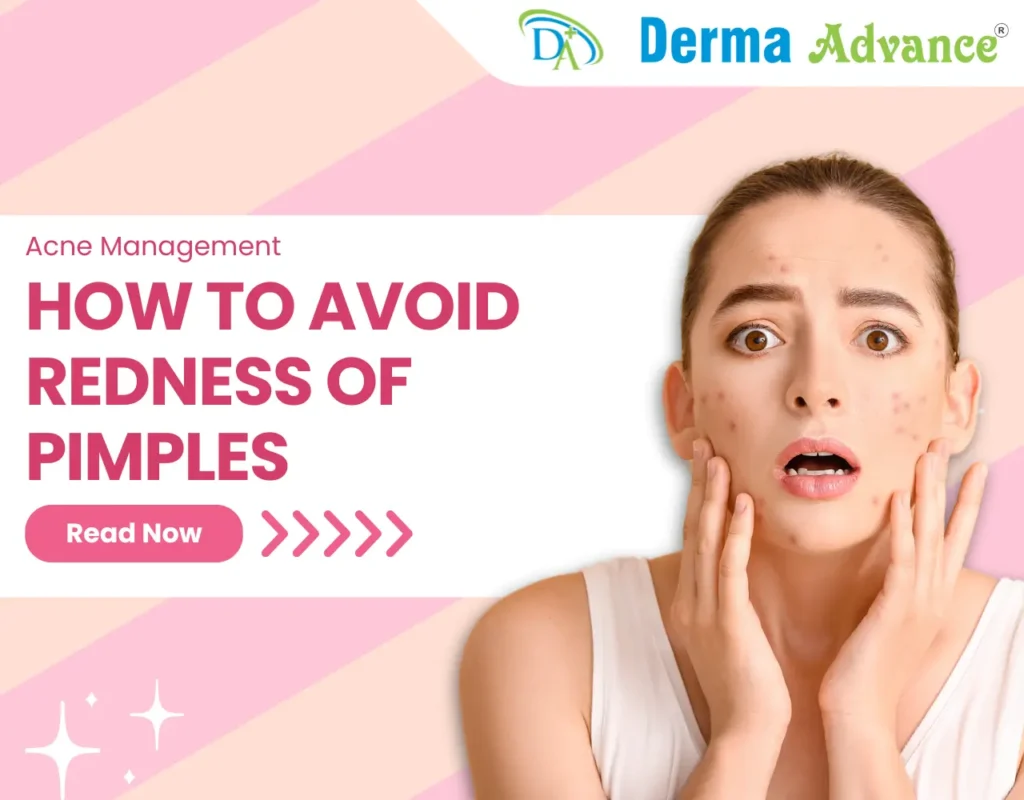Introduction: Understand and avoid Redness of Pimples
Why Pimples Turn Red
When it comes to acne, one of the most noticeable symptoms is redness. But have you ever wondered why pimples turn red in the first place? This redness is actually a result of inflammation, which is your body’s natural response to bacteria and irritants in the skin. As your immune system fights off the bacteria causing the pimple, it increases blood flow to the area. This heightened blood flow brings white blood cells to combat the infection, and that’s where the redness comes from.
But that’s not all. Redness can also be intensified by other factors such as trapped sebum (oil) and dead skin cells clogging the pores. This blockage can irritate the skin, leading to more inflammation and, consequently, more redness. In short, the redness is your body’s way of showing that it’s trying to heal the affected area, but sometimes the process can be a little too aggressive, making pimples appear angrier than they actually are.
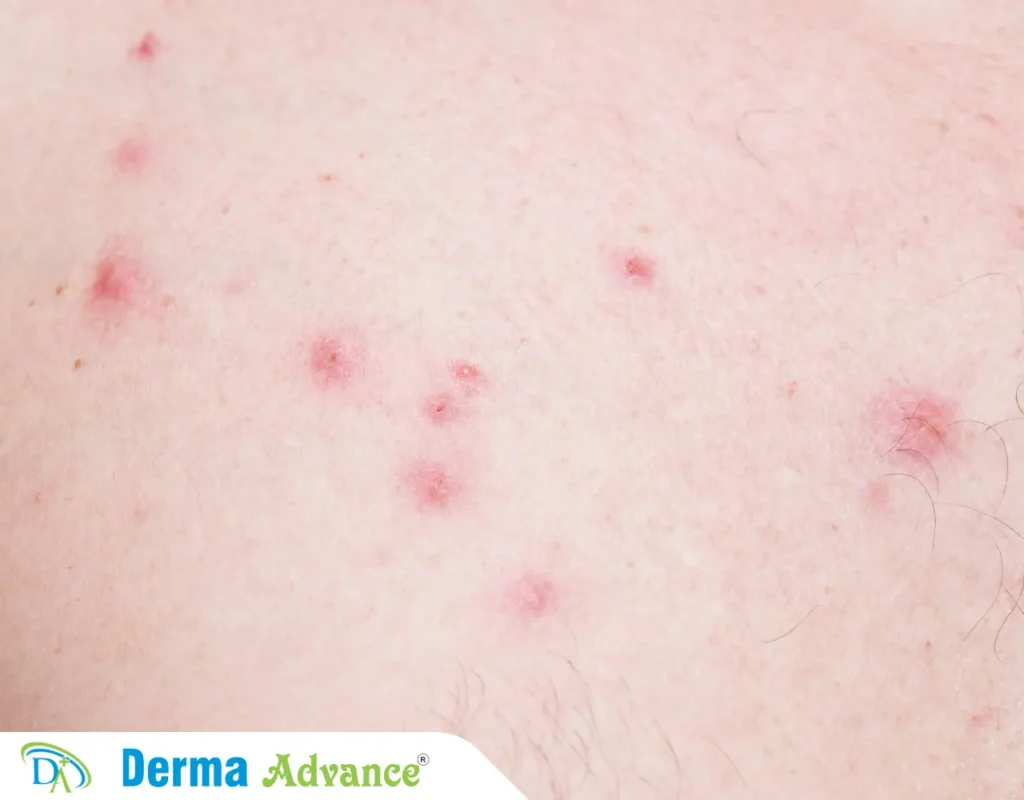
Common Misconceptions About Pimple Redness
There are plenty of misconceptions floating around when it comes to acne, especially about redness. One common myth is that redness means your pimple is healing. While it’s true that redness is part of the healing process, it’s not necessarily a sign that the pimple is about to disappear. In fact, excessive redness can sometimes mean that the inflammation is getting worse.
Another misconception is that if a pimple is red, it must be infected. This is not always the case. Redness does not automatically mean infection. In many cases, it’s simply a sign of irritation from clogged pores or even from using too many harsh skincare products. Differentiating between normal pimple redness and an actual infection is crucial. Infections often come with additional symptoms like swelling, warmth, and pus. If you notice these signs, it’s best to consult a dermatologist for proper treatment.
Table of Contents
Causes of Redness in Pimples
Inflammation and the Body’s Immune Response
One of the primary causes of pimple redness is inflammation, which occurs as part of your body’s immune response. When acne-causing bacteria (such as Propionibacterium acnes) enter a clogged pore, the body recognizes it as a threat. In response, it sends white blood cells to the area to fight the bacteria. This influx of immune cells increases blood flow to the site of the infection, which is why the skin around a pimple becomes red and swollen.
Inflammation is essentially your body’s defense mechanism kicking into high gear. The redness you see is part of this natural process, as the blood vessels in the surrounding area dilate to allow more immune cells to reach the affected site. While this is a necessary step to clear up the infection, it can make pimples appear more inflamed and noticeable, especially if your immune response is particularly strong or if the pimple is large.
Skin Irritation
Redness can also be caused by irritation, which occurs when the skin is exposed to harsh chemicals, over-washing, or even physical friction. Many people unknowingly make their acne worse by using overly harsh cleansers, toners, or exfoliants that strip the skin of its natural oils, causing irritation. This can inflame the skin even more, leading to increased redness around the pimple.
Additionally, frequently touching or picking at pimples can irritate the skin and worsen the redness. Physical friction from everyday objects, such as pillowcases, face masks, or clothing, can also aggravate acne-prone skin. For example, if your pillowcase is not changed regularly, it can harbor bacteria and oil that worsen acne and lead to increased redness.
Hormonal Factors
Hormonal fluctuations are another key factor that can intensify the redness of pimples. During puberty, the body produces excess sebum (oil) due to an increase in androgens, which can clog pores and lead to more severe acne and redness. Similarly, hormonal changes during menstruation, pregnancy, or menopause can lead to hormonal acne flare-ups, which often come with more noticeable redness and inflammation.
When your hormones fluctuate, your skin becomes more sensitive to these hormonal changes, producing more oil and becoming more reactive to acne-causing bacteria. This is why hormonal acne is often deep, painful, and red. Understanding these hormonal patterns can help manage and reduce redness by targeting the root cause.
Dietary and Lifestyle Contributors
Your diet and lifestyle can also play a significant role in the redness of pimples. Certain foods are known to trigger inflammation, leading to worsened acne symptoms, including redness. Foods high in sugar, dairy products, and spicy foods have been linked to increased inflammation in the body, which can manifest as more inflamed, red pimples.
Aside from diet, lifestyle factors such as stress and lack of sleep can exacerbate acne and increase redness. Stress triggers the release of cortisol, a hormone that can increase oil production and inflammation, leading to more prominent pimples. Similarly, not getting enough sleep disrupts the body’s ability to repair itself, worsening the appearance of red, inflamed acne.
Immediate Steps to Reduce Pimple Redness
Cold Compress or Ice
One of the most effective and quick ways on how to avoid redness of pimples is using a cold compress or ice. Cold temperatures constrict the blood vessels underneath the skin, which reduces the flow of blood to the inflamed area, thereby minimizing redness and swelling. Applying a cold compress can instantly soothe irritated skin and decrease the redness of pimples.
To use a cold compress, wrap a few ice cubes in a clean cloth and gently apply it to the affected area for 5-10 minutes. Avoid placing the ice directly on the skin, as it can cause skin damage or frostbite. Repeat this process a few times throughout the day to calm the inflammation and visibly reduce redness. This method is particularly effective in the early stages of a pimple’s formation.
Over-the-Counter Topical Treatments
Another essential tip on how to avoid redness of pimples is using over-the-counter (OTC) topical treatments specifically formulated to reduce acne inflammation. These products often contain ingredients like benzoyl peroxide, salicylic acid, and sulfur, which are known for their anti-inflammatory and acne-fighting properties.
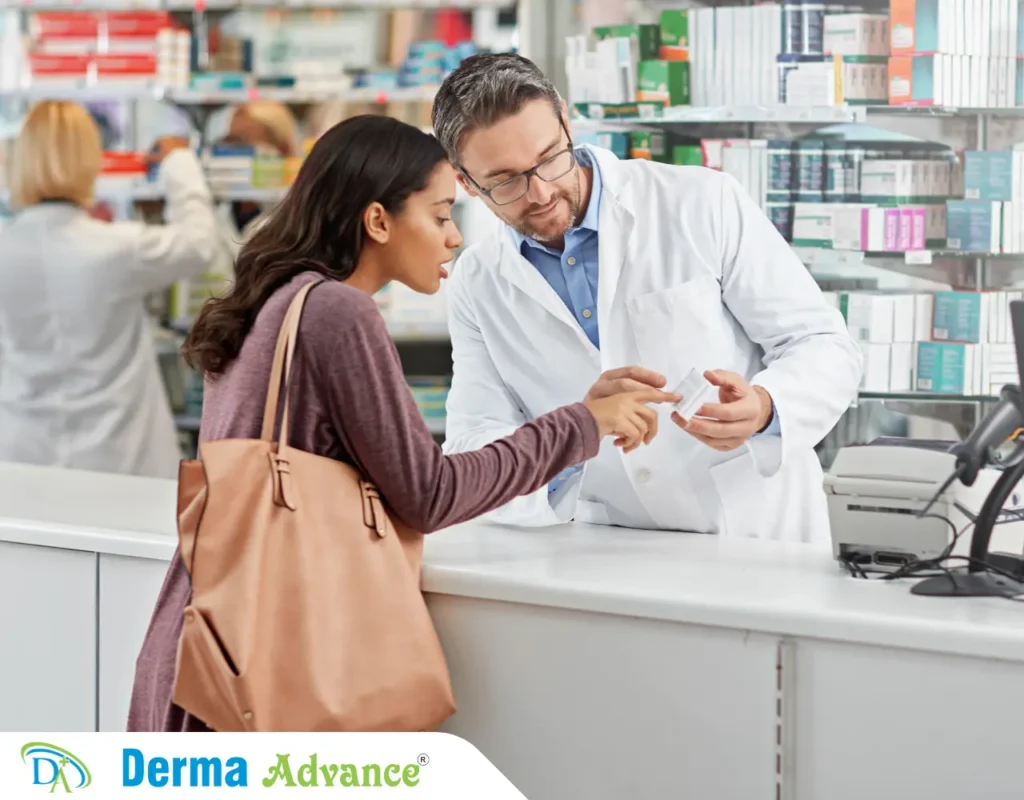
Benzoyl peroxide works by killing acne-causing bacteria, which helps reduce inflammation and redness. It is especially effective for red, inflamed pimples like papules and pustules. Similarly, salicylic acid is an exfoliant that penetrates the pores, clearing out dead skin cells and reducing clogged pores that lead to red, swollen pimples. Sulfur has been used for centuries to treat acne due to its antibacterial and anti-inflammatory properties, making it an ideal option to reduce redness.
When using these treatments, it’s important to follow the instructions and apply the products only to the affected area (as a spot treatment). Overuse can lead to dryness and irritation, which might worsen redness rather than reduce it. Consistent, targeted use of these products can significantly help in how to avoid redness of pimples.
Hydrocortisone Cream for Quick Relief
If you’re looking for fast relief on how to avoid redness of pimples, applying hydrocortisone cream can be incredibly effective. Hydrocortisone is a topical steroid that works by lowering inflammation, making it a popular choice for quickly reducing redness and swelling caused by pimples.
Hydrocortisone cream is particularly helpful for reducing the redness of inflamed pimples that are swollen or painful. However, this should be used sparingly and only as a short-term solution, as long-term use can thin the skin and lead to other side effects. It is best used under the guidance of a dermatologist for how to avoid redness of pimples while ensuring safe and proper application.
To use, apply a very small amount of 1% hydrocortisone cream directly to the red, inflamed pimple once or twice a day. Do not use it on large areas of the skin or for an extended period. Hydrocortisone is especially useful before a big event or when you need a quick fix to calm an angry, red breakout.
In summary, for those seeking immediate solutions on how to avoid redness of pimples, using a cold compress, targeted OTC treatments, and hydrocortisone cream can help calm the skin and reduce visible inflammation effectively.
Long-Term Skincare Practices to Prevent Redness
Developing a Gentle Cleansing Routine
One of the fundamental steps in how to avoid redness of pimples is to develop a gentle cleansing routine. It is crucial to use mild, non-comedogenic cleansers that do not clog the pores or irritate the skin. These types of cleansers help remove excess oil, dirt, and makeup without stripping the skin of its natural moisture. When choosing a cleanser, look for formulations that are labeled as “suitable for sensitive skin” to ensure they are gentle on acne-prone areas.
Over-cleansing can significantly worsen redness and breakouts, as it can strip the skin of its natural oils, leading to an overproduction of sebum as a compensatory mechanism. This overproduction can clog pores and result in more pimples, creating a vicious cycle. For optimal results, clean acne-prone skin twice a day—once in the morning and once at night. This routine can help manage oil levels while minimizing irritation, which is essential for how to avoid redness of pimples.
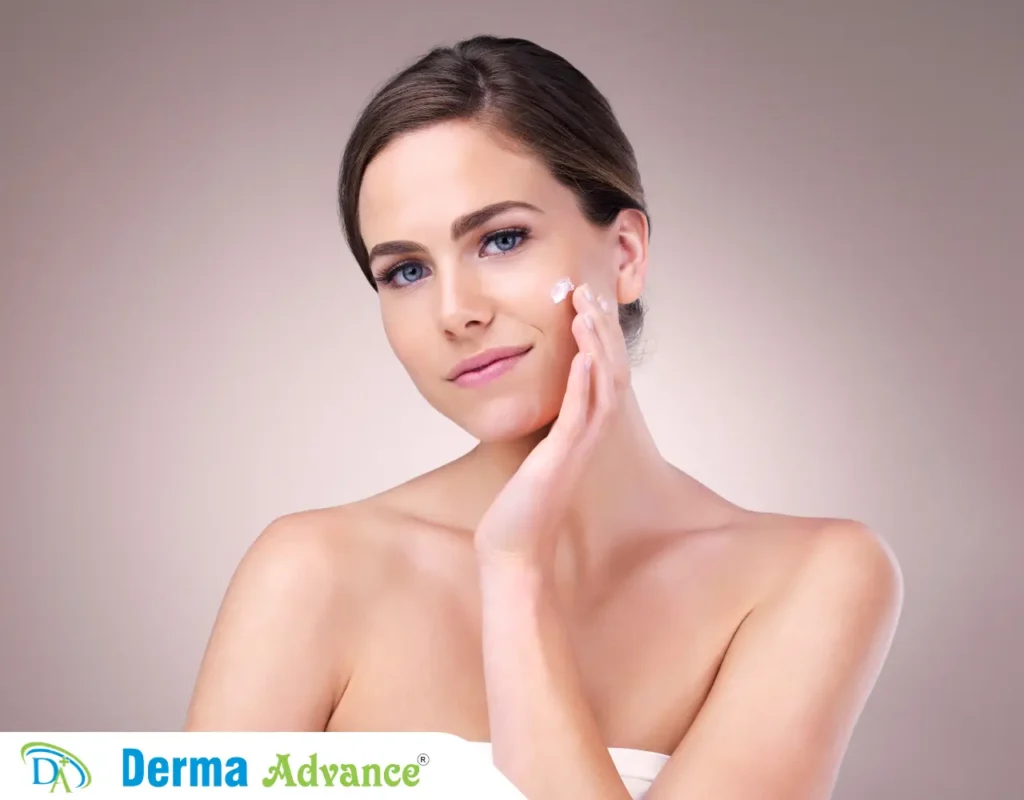
Exfoliating Without Aggravating Pimples
Exfoliation is another critical aspect of how to avoid redness of pimples. However, it is essential to choose the right type of exfoliants. Opting for chemical exfoliants, such as Alpha Hydroxy Acids (AHAs) and Beta Hydroxy Acids (BHAs), is often more beneficial than using physical scrubs that can cause irritation and worsen redness. Chemical exfoliants work by dissolving dead skin cells and promoting cell turnover without the harsh abrasiveness of scrubs.
The frequency of exfoliation should be tailored to your skin type. For those with acne-prone, sensitive skin, it is typically best to exfoliate once or twice a week. This approach helps to keep the skin clear and prevent clogged pores while minimizing the risk of irritation and redness. Incorporating gentle exfoliation into your routine can significantly contribute to how to avoid redness of pimples in the long term.
Moisturization and Hydration
Moisturization is often overlooked when discussing how to avoid redness of pimples, yet it plays a crucial role in maintaining skin health. Even oily skin types need adequate hydration to reduce irritation and support the skin barrier. Using a lightweight, non-comedogenic moisturizer helps keep the skin hydrated without adding excess oil. Look for soothing ingredients like hyaluronic acid, aloe vera, or glycerin, which can provide hydration without clogging pores.
Proper hydration can help balance oil production, leading to fewer breakouts and, consequently, reduced redness. Daily moisturizing is a key practice in preventing the long-term development of redness associated with acne.
Choosing Sunscreens That Prevent Redness
Another important factor in how to avoid redness of pimples is the use of sunscreen. UV exposure can aggravate acne and increase redness, making it essential to protect your skin from harmful rays. Choose a broad-spectrum sunscreen with at least SPF 30 that is labeled as non-comedogenic and designed for sensitive or acne-prone skin. Mineral-based sunscreens containing zinc oxide or titanium dioxide are often gentler and less likely to cause irritation compared to chemical sunscreens.
Incorporating sunscreen into your daily skincare routine is vital, even on cloudy days. This protective measure helps prevent sun damage, which can exacerbate redness and make post-acne marks more pronounced. Prioritizing proper sun protection is a critical part of how to avoid redness of pimples in the long run.
Natural Remedies for Reducing Pimple Redness
Aloe Vera and Its Anti-Inflammatory Properties
Aloe vera has long been celebrated for its soothing and healing properties, making it an excellent natural remedy for reducing pimple redness. The gel extracted from the aloe vera plant contains a variety of beneficial compounds, including vitamins, minerals, and enzymes that work together to calm irritated skin.
One of the primary reasons why aloe vera is effective in how to avoid redness of pimples is its anti-inflammatory properties. When applied topically, aloe vera gel can penetrate the skin and reduce inflammation by inhibiting the production of inflammatory mediators. This helps to diminish the redness associated with pimples while also promoting faster healing of the affected area.
To use aloe vera for reducing redness, simply apply a generous amount of pure aloe vera gel directly onto the affected areas. It is best to do this after cleansing your face to allow the skin to absorb the gel effectively. Leave it on for about 20-30 minutes before rinsing it off with lukewarm water. Regular application can significantly improve the appearance of red, inflamed pimples and is a natural way to practice how to avoid redness of pimples.
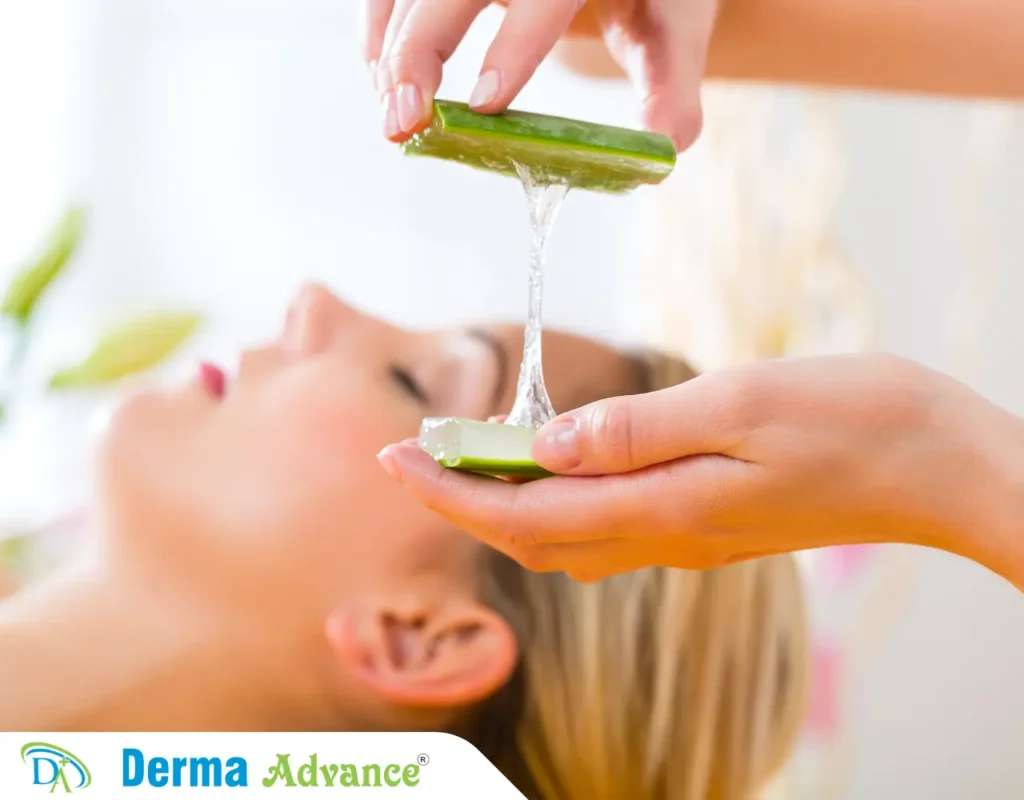
Green Tea Extracts and Antioxidants
Green tea is another powerful natural remedy that can be used to address pimple redness. Rich in antioxidants, particularly catechins, green tea helps to reduce inflammation and improve overall skin health. The anti-inflammatory properties of green tea can effectively calm irritated skin and reduce the visible redness associated with acne.
Research has shown that topical application of green tea extract can significantly lower the production of sebum, the oily substance that can contribute to the formation of pimples. By controlling oil production, green tea not only helps in reducing the occurrence of new breakouts but also plays a crucial role in how to avoid redness of pimples by soothing existing inflammation.
To incorporate green tea into your skincare routine, brew a strong cup of green tea and allow it to cool. Once cooled, you can apply the tea directly to your skin using a cotton ball or a clean cloth. For an added boost, consider using green tea extract or creams that contain green tea as an ingredient. Applying this remedy twice daily can lead to noticeable improvements in redness and overall skin tone.
Honey and Turmeric Masks
Combining honey and turmeric creates a potent mask that effectively addresses pimple redness. Honey is well-known for its antibacterial properties, which can help to prevent the growth of acne-causing bacteria, while turmeric possesses remarkable anti-inflammatory benefits that can significantly reduce redness and swelling.
The combination of these two ingredients creates a powerful mask that not only targets existing pimples but also prevents future breakouts. Honey acts as a humectant, drawing moisture into the skin, which can aid in healing and reducing dryness, while turmeric calms inflammation, making this mask an effective solution for how to avoid redness of pimples.
To create a honey and turmeric mask, mix two tablespoons of raw honey with one teaspoon of turmeric powder. Apply the mixture evenly to your face, focusing on areas with redness or active pimples. Leave the mask on for about 15-20 minutes, then rinse it off with lukewarm water. For best results, use this mask two to three times a week, and watch as the redness diminishes and your skin begins to heal.
Tea Tree Oil for Calming Inflammation
Tea tree oil is a popular natural remedy known for its antibacterial and anti-inflammatory properties. It is particularly effective for reducing the redness associated with pimples, making it a valuable addition to your skincare routine when learning how to avoid redness of pimples.
However, it is crucial to remember that tea tree oil is a potent essential oil and must be diluted before applying it to the skin. Undiluted tea tree oil can cause irritation or a burning sensation, especially on sensitive skin. To safely use tea tree oil, mix one part tea tree oil with three parts of a carrier oil, such as jojoba oil or coconut oil.
Once properly diluted, apply a small amount of the mixture to the affected areas using a clean cotton swab. The anti-inflammatory properties of tea tree oil will work to calm the skin, reduce redness, and prevent future breakouts. For optimal results, incorporate tea tree oil into your skincare routine once a day, and monitor your skin’s response to ensure there is no irritation.
By utilizing these natural remedies—aloe vera, green tea, honey and turmeric masks, and tea tree oil—you can effectively reduce pimple redness and maintain clearer skin. These remedies not only help in how to avoid redness of pimples but also promote overall skin health, making them valuable additions to your skincare regimen.
How Lifestyle Changes Can Prevent Redness in Pimples
Dietary Adjustments to Reduce Inflammation
Making mindful dietary choices is a crucial step in learning how to avoid redness of pimples and improving overall skin health. Certain foods can significantly impact inflammation levels in the body, which directly relates to the redness and severity of pimples.
Anti-Inflammatory Foods
Incorporating anti-inflammatory foods into your diet can help mitigate redness and promote healing. Some of the best options include:
- Omega-3 Fatty Acids: Found in fatty fish like salmon, walnuts, and flaxseeds, omega-3s are known to reduce inflammation throughout the body. These healthy fats can help calm the skin and may play a role in preventing acne flare-ups.
- Leafy Greens: Spinach, kale, and other leafy greens are rich in vitamins, minerals, and antioxidants that combat oxidative stress, thus reducing inflammation and redness associated with acne.
- Berries: Blueberries, strawberries, and raspberries are high in antioxidants, which can help protect the skin from free radical damage and reduce inflammation, making them ideal for those looking to manage how to avoid redness of pimples.
Foods to Avoid
In addition to incorporating beneficial foods, it’s equally important to identify and avoid foods that may trigger inflammation and worsen acne. Here are some common culprits:
- Dairy Products: Milk, cheese, and other dairy products have been linked to increased acne severity in some individuals. Consider reducing your intake to see if it helps lessen redness.
- Refined Carbohydrates: White bread, pastries, and sugary snacks can lead to spikes in blood sugar, which can trigger inflammation and aggravate acne.
- High-Glycemic Foods: Foods that cause rapid spikes in blood sugar, like candy and processed snacks, can worsen acne by increasing insulin levels and promoting inflammation.
Managing Stress Levels to Prevent Acne Redness
Stress is another significant factor that can lead to increased redness in pimples. When you’re stressed, your body releases cortisol, a hormone that can trigger oil production and inflammation in the skin. This reaction can exacerbate existing acne and cause new breakouts.
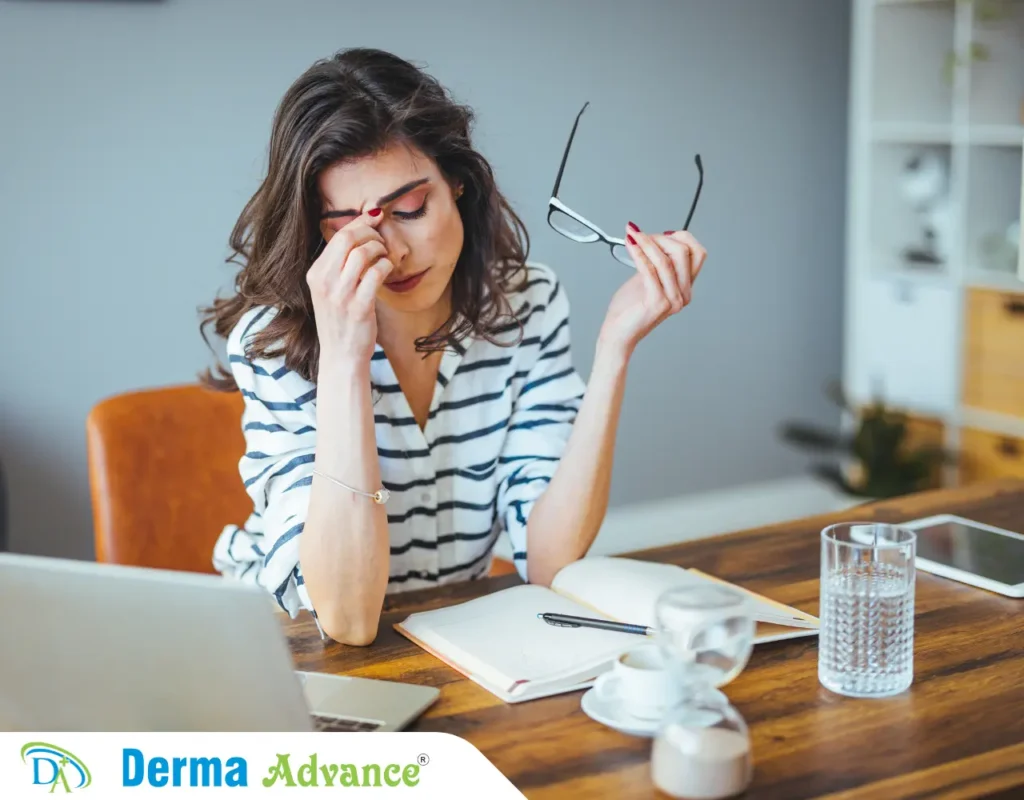
Stress-Induced Cortisol Spikes
The relationship between stress and skin health is well-documented. Elevated cortisol levels can lead to increased sebum production, resulting in clogged pores and heightened inflammation. Understanding how to avoid redness of pimples involves managing stress effectively to minimize its impact on your skin.
Techniques for Reducing Stress
Implementing stress-reduction techniques into your daily routine can significantly benefit your skin:
- Meditation: Practicing mindfulness meditation can help reduce stress levels, leading to lower cortisol production and, in turn, minimizing the risk of redness and acne flare-ups.
- Exercise: Regular physical activity is an excellent way to manage stress. Exercise releases endorphins, which can enhance your mood and reduce stress, contributing to healthier skin.
Adequate Sleep and Its Role in Skin Recovery
Sleep is vital for overall health, but it plays a particularly crucial role in skin recovery and inflammation management. Sleep deprivation can lead to increased redness and exacerbation of acne, making it essential to prioritize quality rest.
How Sleep Deprivation Causes Redness
When you don’t get enough sleep, your body produces higher levels of cortisol, similar to stress. This hormonal imbalance can lead to increased inflammation, causing existing pimples to become redder and more inflamed.
Tips for Better Sleep Hygiene
Improving your sleep hygiene can promote better skin health and help reduce redness:
- Establish a Routine: Aim for a consistent sleep schedule by going to bed and waking up at the same time every day.
- Create a Relaxing Environment: Ensure your bedroom is conducive to sleep by keeping it dark, cool, and quiet. Consider using blackout curtains and white noise machines if necessary.
- Limit Screen Time: Reduce exposure to screens at least an hour before bed. The blue light emitted by devices can disrupt sleep patterns and hinder your body’s ability to recover.
- Practice Relaxation Techniques: Engaging in calming activities like reading, yoga, or deep-breathing exercises before bedtime can help you unwind and improve your sleep quality.
By implementing these lifestyle changes—dietary adjustments, stress management techniques, and better sleep hygiene—you can take significant steps in how to avoid redness of pimples and improve your overall skin health. Each of these factors plays a vital role in maintaining clear skin and preventing the inflammation and redness associated with acne.
Hormonal Causes of Redness: How to Manage Them
Acne During Puberty
Puberty is a transformative time for adolescents, marked by significant hormonal changes that can lead to various skin issues, including increased redness in pimples. Understanding the relationship between hormones and acne is essential for managing this condition effectively.
Why Hormonal Surges During Puberty Make Pimples Redder and More Inflamed
During puberty, the body experiences a surge in hormones such as testosterone, which stimulates the sebaceous glands to produce more oil (sebum). This excess oil can clog pores, leading to the formation of acne. Additionally, the inflammatory response to bacteria trapped in these clogged pores can cause pimples to become redder and more inflamed. As a result, adolescents often experience a more pronounced redness in their acne, making it crucial to address the issue early on.
Skincare Strategies for Managing Hormonal Acne Redness
To manage redness associated with hormonal acne during puberty, consider implementing the following skincare strategies:
- Gentle Cleansing: Use a mild, non-comedogenic cleanser to avoid further irritation and maintain a balanced skin barrier.
- Topical Treatments: Look for products containing salicylic acid or benzoyl peroxide to help reduce inflammation and unclog pores. These ingredients are effective in treating hormonal acne while minimizing redness.
- Moisturizing: Even oily skin needs hydration. Use lightweight, oil-free moisturizers to keep the skin hydrated without clogging pores.
- Regular Exfoliation: Incorporate gentle exfoliation into your routine to remove dead skin cells and prevent clogged pores. Opt for chemical exfoliants like AHAs or BHAs for best results.
Acne in Pregnancy and Menopause
Hormonal fluctuations during pregnancy and menopause can also lead to increased redness in acne. Understanding these changes is vital for effective management.
Why Hormonal Changes in Pregnancy and Menopause Exacerbate Redness
During pregnancy, hormonal changes cause an increase in blood volume and circulation, which can lead to increased redness in the skin, especially around acne lesions. Similarly, menopause brings about significant hormonal shifts, particularly a decline in estrogen levels, which can result in changes in skin elasticity and oil production. These hormonal fluctuations can contribute to heightened inflammation and redness in acne-prone skin.
Safe Treatment Options During Pregnancy and Menopause
When dealing with acne during pregnancy and menopause, it’s crucial to choose safe and effective treatment options:
- Gentle Skincare Products: Opt for pregnancy-safe skincare products that are free from harsh chemicals, retinoids, and salicylic acid at high concentrations.
- Natural Remedies: Consider using natural ingredients like aloe vera, tea tree oil, or green tea extract to soothe inflammation and reduce redness without harmful side effects.
- Consult a Dermatologist: Seek professional advice to develop a personalized skincare regimen that addresses hormonal changes while ensuring safety during pregnancy or menopause.
Birth Control and Hormonal Treatments
Hormonal birth control can play a significant role in managing acne and redness, especially in women with hormone-related breakouts.
The Role of Birth Control in Regulating Acne Redness
Many forms of hormonal birth control, such as the pill, patch, or IUD, can help regulate hormone levels in the body, thereby reducing oil production and inflammation. This regulation can lead to fewer breakouts and less redness in existing acne lesions. It’s important to consult with a healthcare provider to determine the best birth control option tailored to your skin needs.
Other Hormonal Treatment Options for Managing Acne Redness
Aside from birth control, there are several hormonal treatment options available:
- Anti-Androgens: Medications like spironolactone can help block the effects of androgens (male hormones) that contribute to increased oil production and acne, reducing redness and inflammation.
- Hormone Therapy: For women undergoing menopause, hormone replacement therapy may help balance hormones and alleviate acne and its associated redness.
- Customized Treatment Plans: Working with a dermatologist can help you explore these options and find a tailored approach to managing hormonal acne and redness effectively.
Understanding hormonal causes of redness in pimples is key to effective management. By employing the right skincare strategies and treatment options, you can significantly reduce redness and achieve clearer, healthier skin.
Professional Treatments to Combat Pimple Redness
Chemical Peels to Reduce Inflammation and Redness
Chemical peels are a popular professional treatment for addressing various skin concerns, including pimple redness. By using a combination of acids, chemical peels effectively exfoliate the outer layer of skin, promoting cell turnover and reducing inflammation.
How Chemical Peels Exfoliate the Skin, Reducing Redness and Inflammation
During a chemical peel, a solution containing acids such as glycolic acid, salicylic acid, or trichloroacetic acid is applied to the skin. These acids work by loosening the bonds between dead skin cells, allowing them to be easily removed. As the outer layer of the skin is exfoliated, new, healthier skin emerges, which can help reduce the appearance of redness associated with acne.
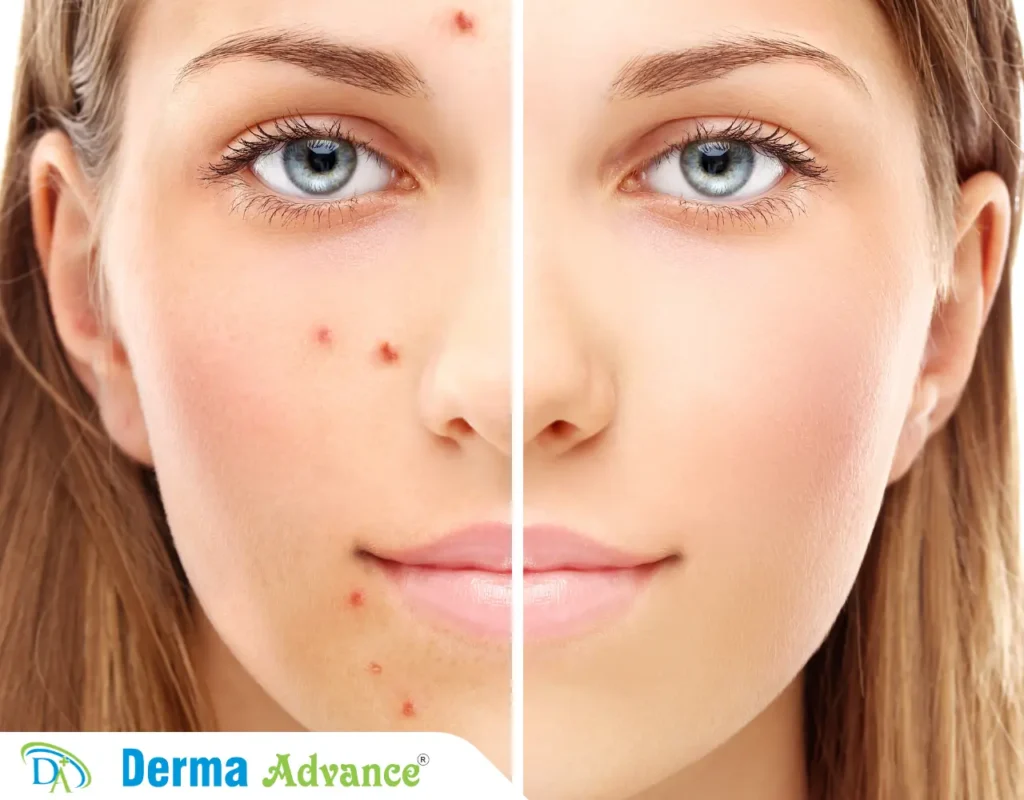
The Best Chemical Peels for Acne-Prone Skin
When considering chemical peels for acne-prone skin, it’s important to choose the right type based on your skin’s needs:
- Salicylic Acid Peels: Particularly effective for oily and acne-prone skin, salicylic acid peels penetrate deep into the pores, helping to unclog them and reduce inflammation.
- Glycolic Acid Peels: These peels are suitable for those with post-acne discoloration, as they promote overall skin rejuvenation and improve skin texture.
- Jessner’s Peel: A combination of salicylic acid, lactic acid, and resorcinol, Jessner’s peels are effective for treating acne scars and reducing redness.
Laser and Light Therapies
Laser and light therapies are advanced treatments designed to target specific skin concerns, including redness caused by acne. These treatments work by delivering focused energy to the skin, helping to alleviate inflammation and improve overall skin tone.
How Laser Treatments Target Redness Caused by Acne
Laser treatments, such as pulsed dye lasers and Nd:YAG lasers, specifically target the blood vessels beneath the skin’s surface. By selectively destroying these blood vessels, laser treatments can effectively reduce the redness associated with inflamed acne lesions. This process not only diminishes redness but also promotes healing in the affected areas.
Blue Light Therapy for Bacterial Acne and Reducing Redness
Blue light therapy is another effective option for those struggling with acne and associated redness. This treatment uses specific wavelengths of blue light to target and kill acne-causing bacteria (Propionibacterium acnes) residing in the skin. By reducing the bacteria, blue light therapy helps minimize inflammation and redness, leading to clearer skin.
Microneedling for Acne Redness
Microneedling is a minimally invasive procedure that involves using fine needles to create micro-injuries in the skin. This stimulates the body’s natural healing processes, promoting collagen and elastin production.
How Microneedling Helps in Reducing Post-Inflammatory Redness
Microneedling can be particularly beneficial for reducing post-inflammatory erythema, a condition where redness persists after acne has healed. By promoting collagen production, microneedling helps improve skin texture and tone, which can lead to a reduction in the appearance of redness over time. The procedure also enhances the absorption of topical treatments, making it an effective complement to other acne therapies.
Overall, professional treatments like chemical peels, laser therapies, and microneedling offer effective solutions for combating pimple redness. Consulting with a qualified dermatologist can help you determine the best treatment plan tailored to your individual skin concerns and needs.
The Role of Makeup in Reducing the Appearance of Redness
Using Color Correctors to Neutralize Redness
Color correctors are a fantastic makeup tool designed to address specific skin concerns, including redness from acne. Among these, green color correctors are particularly effective at neutralizing red tones on the skin, creating a more balanced and even complexion.
How Green Color Correctors Can Reduce the Appearance of Redness
Green color correctors work on the principle of color theory, where opposite colors on the color wheel cancel each other out. When applied to red areas of the skin, green correctors help to neutralize the redness, making it less noticeable. This is especially beneficial for inflamed acne, as it can provide a more even base for foundation and concealer.
Best Practices for Applying Makeup on Inflamed Skin
- Prep the Skin: Start with a gentle, hydrating primer designed for sensitive skin. This will help create a smooth surface for makeup application and minimize further irritation.
- Apply the Corrector Sparingly: Use a small amount of green corrector directly on the red areas using a clean makeup brush or your fingertip. Gently tap it into the skin without rubbing.
- Blend Carefully: After applying the corrector, blend it out with a makeup sponge or brush to ensure an even finish. Avoid harsh movements that could irritate inflamed skin.
- Layer Foundation Gently: Once the corrector is blended, apply a lightweight, non-comedogenic foundation to avoid clogging pores. Use a damp sponge for a natural finish and to prevent caking.
Choosing Acne-Safe Makeup Products
For those with acne-prone skin, selecting the right makeup products is crucial to managing redness and preventing breakouts. The right products can help enhance your appearance without aggravating your skin condition.
The Importance of Non-Comedogenic Makeup for Acne-Prone Skin
Non-comedogenic makeup is formulated specifically to avoid clogging pores, which can lead to increased acne and redness. When shopping for makeup, look for labels that specify “non-comedogenic” or “oil-free.”
- Foundations: Choose lightweight, breathable foundations that provide coverage without suffocating the skin.
- Concealers: Opt for creamy, blendable concealers that can cover blemishes without accentuating redness.
- Setting Sprays and Powders: Look for mattifying products that help keep makeup in place without adding excess oil.
Removing Makeup Properly to Avoid Worsening Redness
Proper makeup removal is essential in maintaining clear skin and preventing further irritation. Leaving makeup on overnight can lead to clogged pores and exacerbated redness. Here are some tips for effective makeup removal:
- Use Gentle Cleansers: Choose a gentle, hydrating cleanser designed for sensitive or acne-prone skin. Avoid harsh scrubs that can irritate inflamed areas.
- Double Cleansing: Consider a two-step cleansing method, starting with an oil-based cleanser to dissolve makeup, followed by a water-based cleanser to remove any residual impurities.
- Be Gentle: When removing makeup, avoid aggressive rubbing. Use soft cotton pads or cleansing cloths to gently wipe away products.
- Follow Up with Skincare: After cleansing, apply a soothing toner or moisturizer to hydrate the skin and calm any residual redness.
By understanding the role of makeup in reducing the appearance of redness and choosing the right products, you can confidently address your skin concerns while still enjoying the benefits of makeup. Always prioritize your skin’s health and opt for products that support clear, healthy skin.
Preventing Redness After a Pimple Heals
Post-Inflammatory Erythema (PIE): What It Is and How to Treat It
Post-Inflammatory Erythema (PIE) refers to the redness that remains on the skin after a pimple has healed. This redness can be a frustrating reminder of past breakouts and may persist for weeks or even months. Understanding PIE is essential for managing it effectively and reducing its duration.
Understanding PIE as a Cause of Lingering Redness
PIE occurs when blood vessels in the skin remain dilated after the inflammation from a pimple subsides. This response can be attributed to the body’s healing process as it repairs damaged skin. While PIE is not harmful, it can be distressing for those who want a clear complexion.
Treatment Options to Fade Post-Pimple Redness
- Topical Treatments: Various over-the-counter creams and gels can help reduce PIE. Look for products containing:
- Niacinamide: Known for its anti-inflammatory properties, it helps to calm redness and improve skin texture.
- Vitamin C: This powerful antioxidant promotes healing and helps brighten the skin, reducing the appearance of redness.
- Retinoids: These can enhance skin cell turnover, promoting healing and fading post-inflammatory redness.
- Laser Therapy: For more stubborn cases of PIE, professional treatments such as laser therapy can effectively target and reduce redness. Common types of laser treatments include:
- Pulse Dye Laser: This laser targets blood vessels, effectively reducing redness.
- Fractional Laser: Helps improve skin texture while also addressing redness.
- LED Light Therapy: Using red or blue LED light can help calm inflammation and promote healing, making it a great option for reducing PIE.
How to Avoid Post-Pimple Redness Scarring
Preventing post-pimple redness from turning into permanent scars is crucial for maintaining clear skin. Here are some effective techniques:
Techniques for Preventing Red Marks from Turning into Permanent Scars
- Don’t Pick or Squeeze: Picking at pimples can exacerbate inflammation and increase the risk of scarring. It’s essential to avoid this temptation.
- Use Sun Protection: Sun exposure can darken red marks and scars, making them more noticeable. Always apply a broad-spectrum sunscreen with at least SPF 30 to protect healing skin.
- Keep the Skin Moisturized: Proper hydration promotes healing and reduces the risk of scarring. Use a gentle, non-comedogenic moisturizer to keep the skin supple.
- Incorporate Gentle Exfoliation: After the skin has fully healed, incorporating gentle exfoliation can help fade redness. Opt for chemical exfoliants like AHAs and BHAs rather than harsh physical scrubs.
- Consider Professional Treatments: If you notice red marks persist after healing, consult a dermatologist for personalized treatment options, which may include chemical peels or microneedling to encourage skin regeneration.
By understanding Post-Inflammatory Erythema and implementing these techniques, you can significantly reduce the likelihood of lingering redness after a pimple heals, leading to a clearer and more even complexion.
Do’s and Don’ts for Avoiding Pimple Redness
Do’s:
- Use Gentle Products: Always opt for gentle, non-comedogenic skincare products designed for sensitive skin. Look for labels that specify “fragrance-free” and “hypoallergenic” to minimize irritation.
- Apply Cold Compresses: When you notice redness, apply a cold compress or ice wrapped in a cloth to the affected area for about 10–15 minutes. This can help reduce inflammation and redness effectively.
- Opt for Non-Irritating Treatments: Choose treatments with soothing ingredients such as niacinamide, aloe vera, and chamomile. These ingredients can help calm the skin and reduce redness without causing further irritation.
Don’ts:
- Avoid Picking or Squeezing Pimples: It can be tempting to pop pimples, but this can lead to increased inflammation, infection, and ultimately more redness. Allow pimples to heal naturally to minimize redness.
- Stay Away from Harsh Exfoliants or Cleansers: Products containing strong scrubs or harsh chemical exfoliants can irritate the skin, leading to more redness. Instead, opt for mild exfoliants like gentle AHAs or BHAs and use them sparingly.
- Don’t Overuse Active Ingredients Like Benzoyl Peroxide: While benzoyl peroxide can be effective for acne treatment, overusing it can lead to excessive dryness and irritation, increasing redness. Stick to the recommended usage guidelines and consider alternating with gentler treatments.
By following these do’s and don’ts, you can effectively manage pimple redness and promote a healthier complexion.
Consulting a Dermatologist for Redness Management
When to Seek Professional Help
Understanding when to consult a dermatologist is crucial in effectively managing pimple redness. Here are some signs that indicate the need for professional intervention:
- Persistent Redness: If redness around your pimples lasts for more than a few days despite home treatments, it’s time to seek help.
- Increased Swelling or Pain: If your acne is becoming increasingly swollen, painful, or tender, this could indicate a more serious condition.
- Signs of Infection: If you notice pus, extreme tenderness, or fever, consult a dermatologist immediately to address potential infections.
- Frequent Breakouts: If you experience frequent breakouts along with persistent redness, a dermatologist can provide insights and treatments tailored to your skin.
A dermatologist may recommend various treatments for persistent redness, including:
- Topical or oral medications, such as antibiotics or retinoids, to help reduce inflammation.
- Procedures like chemical peels or laser therapy to target redness and promote clearer skin.
- Customized skincare products designed to reduce sensitivity and improve overall skin health.
Tailored Skincare Plans for Severe Redness
When managing severe redness, dermatologists create personalized skincare plans that consider your skin type, acne triggers, and overall health. Here’s how they approach treatment:
- Comprehensive Skin Assessment: Dermatologists conduct thorough assessments, including skin type analysis and evaluation of acne history, to develop a tailored treatment plan.
- Customized Treatment Options: Based on the assessment, dermatologists may recommend a combination of topical treatments, oral medications, and professional procedures aimed at reducing both acne and redness.
- Ongoing Monitoring: Regular follow-up appointments allow dermatologists to monitor your progress and make adjustments to your skincare regimen as needed, ensuring optimal results.
At Derma Advance, our team of experienced dermatologists understands the complexities of managing acne and redness. We provide comprehensive consultations to identify your unique needs and create personalized skincare plans that effectively target inflammation and promote healthier skin. Our commitment to patient care ensures you receive the support you need on your journey to clearer skin.
Conclusion: Achieving Clear, Redness-Free Skin
Recap of the Main Points
In summary, understanding how to avoid redness of pimples is essential for maintaining clear and healthy skin. The main strategies include:
- Identifying Causes: Recognizing the various factors that contribute to pimple redness, such as inflammation, irritation, and hormonal changes.
- Immediate Relief Techniques: Utilizing cold compresses, over-the-counter treatments, and hydrocortisone creams for quick reduction of redness.
- Long-Term Skincare Practices: Establishing a gentle cleansing routine, appropriate exfoliation, and consistent moisturization to prevent irritation and redness.
- Natural Remedies: Incorporating soothing ingredients like aloe vera, green tea, honey, and turmeric into your skincare regimen for their anti-inflammatory properties.
- Lifestyle Changes: Making dietary adjustments, managing stress, and ensuring adequate sleep to support skin health and minimize redness.
- Professional Treatments: Considering chemical peels, laser therapies, and tailored skincare plans from a dermatologist for persistent or severe redness.
Consistency Is Key to Preventing Pimple Redness
Ultimately, the key to achieving and maintaining redness-free skin lies in consistency. A regular skincare routine tailored to your unique skin type is essential. Combine this with a balanced diet rich in anti-inflammatory foods and healthy lifestyle habits, such as stress management techniques and adequate sleep. Consistency not only helps in managing existing redness but also plays a crucial role in preventing future breakouts and irritation.
At Derma Advance, we understand the importance of a holistic approach to skincare. Our team is dedicated to providing personalized solutions and ongoing support to help you achieve clear, healthy, and redness-free skin. Whether you’re dealing with occasional breakouts or persistent redness, we’re here to guide you on your journey to optimal skin health.
FAQs About Redness in Pimples
Does drinking water really help prevent acne redness?
Staying hydrated is crucial for overall skin health. While drinking water alone may not directly prevent acne redness, it helps maintain skin elasticity and moisture, potentially reducing the severity of breakouts and inflammation. Proper hydration can support your skin’s natural healing processes, contributing to a more balanced complexion.
Can stress alone cause breakouts and redness?
Yes, stress can play a significant role in the development of acne and redness. When you experience stress, your body produces more cortisol, which can lead to increased oil production and inflammation in the skin. Managing stress through techniques like meditation, exercise, or yoga can help reduce the likelihood of stress-induced breakouts and redness.
Which foods should I avoid to prevent acne redness?
To minimize acne redness, it’s best to avoid foods that may trigger inflammation, such as:
Dairy products: Some studies suggest that dairy may exacerbate acne for certain individuals.
Refined carbohydrates: Foods high in sugar and white flour can lead to spikes in insulin, potentially increasing acne.
High-glycemic index foods: These can cause rapid changes in blood sugar levels, leading to inflammation.
How often should I cleanse my face to prevent acne redness?
For acne-prone skin, it is generally recommended to cleanse your face twice a day—once in the morning and once at night. Use a gentle, non-comedogenic cleanser to avoid stripping the skin of its natural oils, which can lead to irritation and increased redness. Avoid over-cleansing, as this can exacerbate redness and lead to more breakouts.
Is it safe to exfoliate daily if I have acne-prone skin?
Exfoliating daily is usually not recommended for acne-prone skin, as it can lead to irritation and worsen redness. Instead, opt for gentle exfoliation 1-2 times a week using chemical exfoliants like AHAs or BHAs, which are less abrasive than physical scrubs. Always monitor your skin’s response and adjust your routine as needed.
Can over-the-counter treatments be effective for hormonal acne redness?
Over-the-counter treatments containing active ingredients like benzoyl peroxide, salicylic acid, or retinoids can be effective for managing hormonal acne and reducing redness. However, it’s essential to choose products tailored to your skin type and concerns. For persistent hormonal acne, consulting a dermatologist for personalized advice is recommended.
Does sun exposure help or worsen acne redness?
While some people believe that sun exposure can help dry out acne, excessive sun exposure can worsen redness and lead to skin damage. UV rays can cause inflammation and hyperpigmentation, leading to darker spots after a pimple heals. It’s important to use a non-comedogenic sunscreen daily to protect your skin from harmful UV rays and prevent further irritation.
What are the best acne treatments for sensitive skin?
For sensitive skin, it’s best to use gentle, non-irritating treatments. Look for products that contain:
Salicylic acid: A gentle exfoliant that helps unclog pores.
Aloe vera: Known for its soothing properties, it can help reduce inflammation.
Green tea extract: An antioxidant with anti-inflammatory properties.
Always patch test new products and consult a dermatologist if you experience persistent redness or irritation.
How can I prevent acne from leaving scars?
To prevent acne from leaving scars, avoid picking or squeezing pimples, as this can lead to further irritation and scarring. Use gentle treatments to manage breakouts and reduce inflammation. After healing, consider using products with ingredients like niacinamide or retinoids, which can help fade post-acne marks and improve skin texture.

